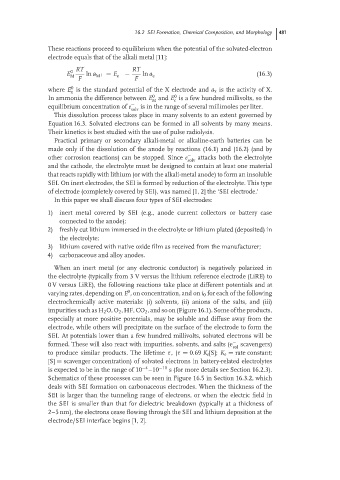Page 508 - Handbook of Battery Materials
P. 508
16.2 SEI Formation, Chemical Composition, and Morphology 481
These reactions proceed to equilibrium when the potential of the solvated-electron
electrode equals that of the alkali metal [11]:
RT RT
E 0 ln a + = E − − (16.3)
M M e ln a −
e
F F
0
where E is the standard potential of the X electrode and a x is the activity of X.
x
0
0
In ammonia the difference between E and E is a few hundred millivolts, so the
c
M
equilibrium concentration of e − is in the range of several millimoles per liter.
solv
This dissolution process takes place in many solvents to an extent governed by
Equation 16.3. Solvated electrons can be formed in all solvents by many means.
Their kinetics is best studied with the use of pulse radiolysis.
Practical primary or secondary alkali-metal or alkaline-earth batteries can be
made only if the dissolution of the anode by reactions (16.1) and (16.2) (and by
other corrosion reactions) can be stopped. Since e − attacks both the electrolyte
solv
and the cathode, the electrolyte must be designed to contain at least one material
that reacts rapidly with lithium (or with the alkali-metal anode) to form an insoluble
SEI. On inert electrodes, the SEI is formed by reduction of the electrolyte. This type
of electrode (completely covered by SEI), was named [1, 2] the ‘SEI electrode.’
In this paper we shall discuss four types of SEI electrodes:
1) inert metal covered by SEI (e.g., anode current collectors or battery case
connected to the anode);
2) freshly cut lithium immersed in the electrolyte or lithium plated (deposited) in
the electrolyte;
3) lithium covered with native oxide film as received from the manufacturer;
4) carbonaceous and alloy anodes.
When an inert metal (or any electronic conductor) is negatively polarized in
the electrolyte (typically from 3 V versus the lithium reference electrode (LiRE) to
0 V versus LiRE), the following reactions take place at different potentials and at
0
varying rates, depending on E , on concentration, and on i 0 for each of the following
electrochemically active materials: (i) solvents, (ii) anions of the salts, and (iii)
impurities such as H 2 O, O 2 , HF, CO 2 , and so on (Figure 16.1). Some of the products,
especially at more positive potentials, may be soluble and diffuse away from the
electrode, while others will precipitate on the surface of the electrode to form the
SEI. At potentials lower than a few hundred millivolts, solvated electrons will be
formed. These will also react with impurities, solvents, and salts (e − scavengers)
sol
to produce similar products. The lifetime τ,(τ = 0.69 K e [S]; K e = rate constant;
[S] = scavenger concentration) of solvated electrons in battery-related electrolytes
is expected to be in the range of 10 −4 –10 −10 s (for more details see Section 16.2.3).
Schematics of these processes can be seen in Figure 16.5 in Section 16.3.2, which
deals with SEI formation on carbonaceous electrodes. When the thickness of the
SEI is larger than the tunneling range of electrons, or when the electric field in
the SEI is smaller than that for dielectric breakdown (typically at a thickness of
2–5 nm), the electrons cease flowing through the SEI and lithium deposition at the
electrode/SEI interface begins [1, 2].

